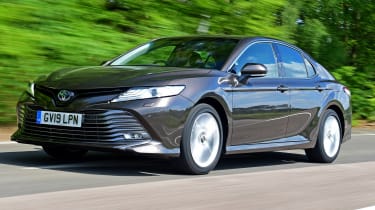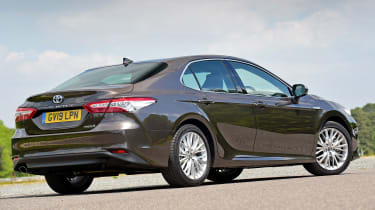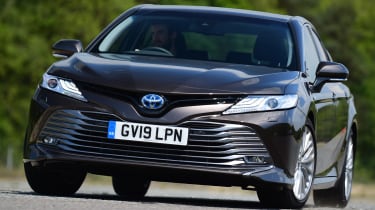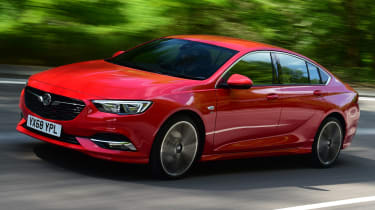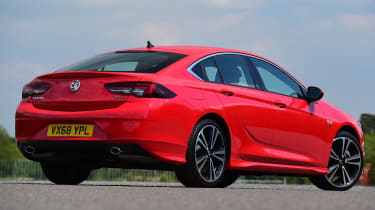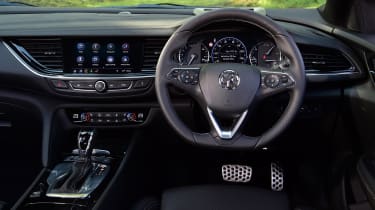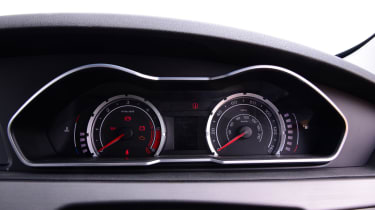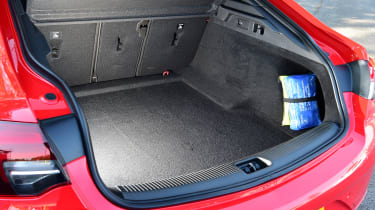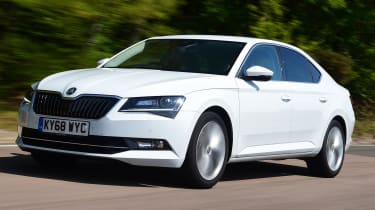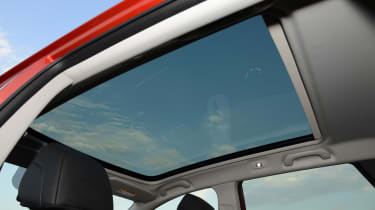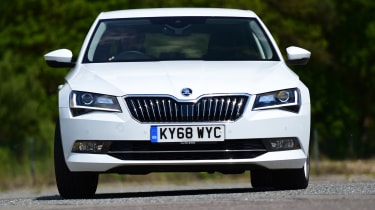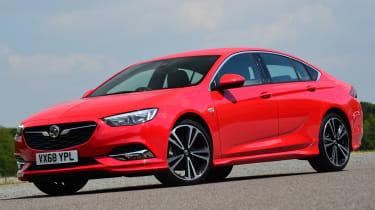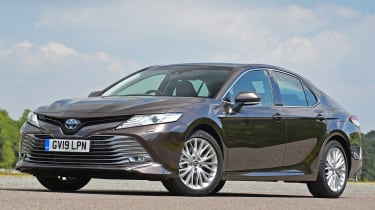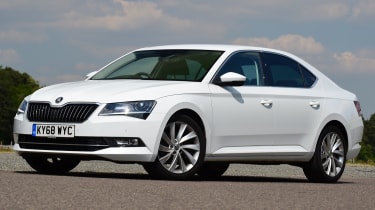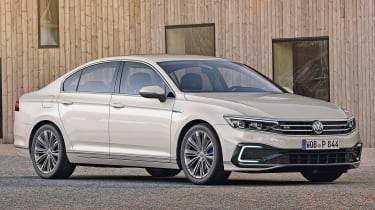Toyota Camry vs Vauxhall Insignia Grand Sport vs Skoda Superb
We pit the new Toyota Camry against the Vauxhall Insignia Grand Sport and Skoda Superb to find out if the Camry is a welcomed return
Family saloons used to be at the very heart of the automotive industry, but fashions change and now everyone wants an SUV instead.
The new Toyota Camry – a big family four-door car that’s also reintroducing the Japanese brand’s famous nameplate back into the UK after a 15-year break – is offering an alternative, though, and it’s no surprise this new Toyota is a hybrid.
Diesel used to dominate this sector, but a rapid change in policy has seen a switch to petrol, so even since the Vauxhall Insignia Grand Sport was launched, diesel sales have died off. However, there’s no hybrid option with the British brand’s hatch, so to line up on price, it’s the 1.6 Turbo 200 model we’re testing. This offers similar power to the Camry as well.
Similar money only buys a 1.5-litre TSI petrol version of the Skoda Superb with 148bhp, although the kit stacks up, which is key for these motors that’ll mostly be run by business users.
Alongside equipment and efficiency, running costs, ride comfort and refinement, technology and usability will be key components that the best in the business will have to combine here, so let’s see which model blends those attributes to greatest effect in our group test.
Toyota Camry
| Model: | Toyota Camry 2.5 Hybrid Design |
| Price: | £29,995 |
| Engine: | 2.5-litre 4cyl plus electric motor, 215bhp |
| 0-60mph: | 7.7 seconds |
| Test economy: | 37.9mpg/8.3mpl |
| CO2: | 98g/km |
| Annual road tax: | £130 |
There are just two Camry models to choose from: the top-spec Excel and this entry-level Design trim, which costs £29,995. Both versions have the same engine, so the choice will only really come down to how much equipment you need.
Design & engineering
Design spec may be the lower of the trims, but it offers plenty of kit. Basically, everything is standard, including adaptive cruise control, front and rear parking sensors, some solid safety tech, a rear-view camera, Bluetooth, sat-nav, heated leather seats, keyless operation and LED lights.
More reviews
It’s short on connectivity, but then the Excel doesn’t improve on this, either. The top-spec car doesn’t really bring a higher-quality feel; while the materials are acceptable, they’re not as nice as those in the Skoda, and trail the Vauxhall’s, too.
The cabin design is functional and therefore fairly practical, but there’s very little in the way of sparkle or excitement. It’s all, well, a bit boring; you can see why people are moving to more stylish SUVs.
At least there’s more interest when it comes to the powertrain because it’s a fairly familiar but still relatively technologically advanced installation.
It teams a 2.5-litre four-cylinder petrol engine with an electric motor to help boost performance, instead of its rivals’ turbos. Both forms of propulsion drive the front wheels through a CVT automatic box.
The engine produces 176bhp, while the electric motor tops this up to a total of 215bhp, so the Toyota is the most powerful car here. However, it’s also the heaviest, due to the old-school nickel-metal hydride battery; the Camry weighs in at 1,595kg, which is around 200kg heavier than the Skoda, for example.
Still, the Toyota New Global Architecture platform can cope with the weight and uses MacPherson-strut front and double-wishbone rear suspension, which is quite a sophisticated layout.
Overall, the Japanese model is well equipped for the cash, offering loads of standard features, but it just doesn’t feel as upmarket and the quality isn’t on par with even its mainstream rivals here.
Driving
With every iteration of its hybrid powertrains, Toyota is improving performance, feel and refinement, and the Camry shows how good integration of engine, motor and chassis can make a hybrid aimed at fleet customers and business users an enticing prospect.
That’s because the torque fill from the electric motor means you don’t have to rev the Camry too hard,but this is only if you’re not bothered about getting anywhere quickly. Otherwise, you have to stretch the petrol engine more. Do so and, while refinement takes a dip, the performance is more acceptable. The Camry accelerated from 0-60mph in 7.7 seconds, which was only 0.2 seconds behind the lighter and similarly powerful Vauxhall.
We couldn’t record in-gear figures due to the CVT, but there’s enough mid-speed performance here. Plus the gearbox has less of the typical surging feel CVTs used to be known for. You have a more direct connection with the powertrain than before, which is a positive, but like the steering, it never really excites when you’re behind the wheel. It’s acceptable but not as dynamic as the two cars it’s up against.
That new platform does mean it’s comfortable, though, riding bumps well and with a softer edge to the body control. It’s only towards the Camry’s limits that it starts to float and wallow, but the car’s character encourages a more easy-going, eco-focused style. Roll back the revs and it’s a relaxing way to get around.
Practicality
The Camry is the only saloon here – the other two cars have huge hatchbacks – so while the boot opening is a little more restrictive for loading bulkier items, it edges ahead of the Vauxhall with 524 litres of luggage space. It’s still some way behind the cavernous Skoda, however.
You sit quite high, so visibility is good, but despite the car’s size, the front of the cabin feels like there’s lots of plastic and seems a little short on storage. The Superb offers the most space for oddments. All three have all-round parking sensors, but the Toyota is the only one with a rear-view camera as standard.
Ownership
Toyota is traditionally a strong performer in our Driver Power satisfaction survey, but it only finished 10th in our 2019 makers’ table. It was some way ahead of 29th-placed Vauxhall, yet Skoda took fifth place.
Camrys get a five-year unlimited mileage warranty, which is good for business users because it shows the brand’s confidence in its hybrid tech. It’s been perfecting this for years and the set-up is very reliable.
Euro NCAP hasn’t crash-tested the Toyota yet, but safety kit is good, with all models offering autonomous braking with pedestrian detection and collision warning, adaptive cruise, lane departure alert and auto high beam. You’ll have to go for Excel spec to get cross-traffic alert and blind spot monitoring.
Running costs
Toyota reckons 80 per cent of users will be from the fleet market, so it’s fair to say company car tax is a big issue. With the hybrid system helping reduce CO2 emissions to 98g/km, the Camry has the lowest tax bill, at £2,743 for higher-rate earners, despite being the priciest car, thanks to a 23 per cent Benefit-in-Kind (BiK) rating.
The 153g/km Vauxhall is in the 34 per cent bracket, so you’ll pay a whopping £1,208 more per year in company car tax, while the Skoda’s cleaner 123g/km unit means a rating of 28 per cent and a tax bill of only £399 more than the Camry. But you obviously get less power with the Superb, too.
Testers' notes
“While there’s less capability for all-electric running than with a plug-in hybrid, there’s the performance, comfort and practicality of a big-engined car with the emissions and running costs of a much smaller model.”
Vauxhall Insignia Grand Sport
| Model: | Vauxhall Insignia Grand Sport 1.6 Turbo 200 auto SRi VX-Line Nav |
| Price: | £29,635 |
| Engine: | 1.6-litre 4cyl turbo, 197bhp |
| 0-60mph: | 7.5 seconds |
| Test economy: | 35.3mpg/7.8mpl |
| CO2: | 153g/km |
| Annual road tax: | £140 |
The Insignia Grand Sport is our favourite big family car, but are the traits that make it a winner still present with this 1.6 Turbo petrol auto powertrain? In SRi VX-Line Nav spec it comes in at £29,635, just a little less than the Toyota.
Design & engineering
Under the skin is Vauxhall’s E2XX platform, which was designed for the Insignia. Features such as a longer wheelbase were key to boosting practicality, while as with many other cars in its range – such as the Astra and the upcoming Corsa – Vauxhall focused heavily on weight reduction here, too.
The Insignia is therefore up to 175kg lighter than its predecessor, which helps in every area, including agility, efficiency and comfort. As much as 60kg of that saving has come from the body, while lightweight components for the suspension and in other areas have helped to keep the mass down, too.
Vauxhall chose suspension technology that is conventional enough for this class, but differs from the Toyota’s set-up slightly, with MacPherson struts at the front and a multi-link rear axle. Adaptive dampers are available on this model as well.
SRi VX-Line Nav cars use a 1.6-litre four-cylinder turbo petrol engine, which has a similar capacity to the Skoda’s, but is more powerful, kicking out 197bhp and 300Nm of torque. It’s closer on paper to the Camry’s petrol-electric hybrid combination.
Unlike the Toyota, the British hatchback features a six-speed automatic transmission rather than a CVT, although it does still drive the front wheels.
It broadly matches the Camry Design for kit, too, pegging it in key areas with features such as sat-nav, climate control, front and rear parking sensors, some core safety kit, DAB radio and LED lights as standard.
While it loses out on factors such as a reversing camera (a £275 option) and heated seats (part of a £510 pack on the Insignia), it does get much stronger connectivity as standard, with Apple CarPlay and Android Auto-included.
Quality is slightly stronger than with the Camry. The hard plastics in the Vauxhall’s cabin are more forgiving than the Toyota’s, while the softer areas of the interior also feel just a little more premium.
Driving
In SRi Nav VX-Line spec the Vauxhall gets standard 20-inch alloy wheels, which look good but corrupt the usually compliant-feeling Insignia’s ride a little. However, this trim level also brings Vauxhall’s FlexRide adaptive dampers with this 197bhp 1.6 turbo engine. Select the softer Tour mode and it loosens the chassis up again to the point where the car rides rifts in the road with the compliance you’d want.
We’d generally always select this setting because body control is still good and you don’t sacrifice any precision in the steering, which is light and seems quicker than the Toyota’s. The Grand Sport feels much more agile due to its far lower kerbweight, too.
That also helped its performance, with the Insignia 0.2 seconds quicker than the Toyota from 0-60mph, taking 7.5 seconds. It was also 0.1 seconds faster going from 30 to 70mph through the gears (or kickdown in the Camry), taking 6.7 seconds, so performance is even between the two cars.
Yet the Vauxhall is more refined when pushed harder. It’s as comfortable and quiet as the Toyota on a motorway, which allied to its adequate six-speed auto, means it’s a fine cruiser. That it balances performance and a hint of driving enjoyment with these traits makes it easy to live with every day and is a real strong point.
Practicality
Unlike the Camry, the Insignia Grand Sport is a hatchback rather than a saloon, so although it offers less boot space, at 490 litres, access is easier thanks to that big void. It should also be able to stow bulkier items, while the level of space should be enough for most owners.
The cabin is cavernous in the back, and the sloping roofline doesn’t impact headroom. There’s lots of space, while legroom is great. It’s a bit tighter in the front, where the dashboard and centre console seem to impinge on space a little, but storage is fine and the ergonomics are a match for the Camry’s.
Ownership
Vauxhall finished way down the order in our Driver Power 2019 poll, taking 29th spot out of 30 makers. It’s not a great result, but at least safety should be better.
The Insignia received a full five-star Euro NCAP rating when it was crash-tested in 2017, and that’s thanks to this SRi VX-Line Nav model’s standard autonomous braking and lane-keep assist. You have to pay £650 extra for blind spot assist as part of the Driving Assistance Pack Four, but this also adds a rear-view camera and cross traffic alert.
Running costs
The Insignia lags behind on predicted residual values. Our experts estimate it’ll hold onto 36.1 per cent of its original price, compared with 39.7 per cent for the Skoda and a more impressive 45.3 per cent for the Toyota.
This means the three cars will be worth £10,704, £11,227 and £13,600 respectively after a typical three-year/36,000-mile ownership period. Yet as many people will buy as company cars, this might be less important. Fuel economy could therefore swing it.
The Vauxhall returned a respectable 35.3mpg given its performance, for an annual fuel bill of £1,978. The less powerful Skoda just trumped it with 35.9mpg and an annual cost of £1,945. But the hybrid Toyota offered 37.9mpg and a fuel bill of £1,842 per year. If you’re after economy, though, a diesel version of the other two models is likely to be much better again.
Testers’ notes
“This powertrain doesn’t make the most sense. For efficiency to match the Camry Hybrid, go for a diesel. You’ll pay more company car tax due to higher CO2, but there’s more choice and much better economy.”
Skoda Superb
| Model: | Skoda Superb 1.5 TSI 150 DSG ACT SE L Executive |
| Price: | £28,280 |
| Engine: | 1.5-litre 4cyl turbo, 148bhp |
| 0-60mph: | 9.1 seconds |
| Test economy: | 35.9mpg/7.9mpl |
| CO2: | 123g/km |
| Annual road tax: | £140 |
The Superb is one of the best Skodas on sale and it’s a former Auto Express award winner. It’s not hard to see why, given the car’s blend of talents that we’ll go into, but competition is close in this class, so can the Superb 1.5 TSI 150 DSG in SE L Executive trim match the Camry and Insignia?
Design & engineering
At £28,280, the Skoda undercuts the Toyota by £1,715 and the Vauxhall by £1,355. There are some important distinctions to make, though. The first is that for this price you only get a 148bhp 1.5-litre four-cylinder turbo petrol engine linked to a seven-speed DSG dual-clutch automatic gearbox; if you want a pokier petrol Superb, the next rung up the ladder is the 268bhp 2.0 TSI SportLine model, which is significantly more powerful and a lot pricier, at £35,130.
Superbs use the MQB platform adopted by Skoda as part of the VW Group family. This is a modular set-up that’s been stretched to pretty much as long as it can go. While the body isn’t quite as long as the Vauxhall’s, its wheelbase is the largest of this trio.
The cabin is also the most premium. The materials are the plushest, the layout the most logical and the tech the slickest-operating, so it beats the Camry and Insignia by a small but significant margin here.
SE L Executive trim also features plenty of kit, with front and rear parking sensors, autonomous braking, adaptive cruise and climate control included in that slightly lower purchase price. There are also heated seats, LED lights, keyless operation, nav and decent phone connectivity.
However, you do have to pay £355 for a reversing camera, which might be useful, given the Superb’s size. Aside from this, there’s little to complain about inside the SE L Executive model.
Driving
That’s not quite the same once you get under way. Straight away the powertrain comes in for questioning, because the DSG gearbox’s clutch take-up is strange, sometimes surging or lagging and then moving off aggressively. It’s not the smoothest way to make progress, while some of the shifts at lower revs when coming to a standstill are also a little clunky. These points affect the Superb’s low-speed driveability.
It also doesn’t feel as flexible as either rival, due to that lower power output. Less torque in a big car like this (250Nm compared with 300Nm in the Vauxhall) means you have to work that 1.5-litre TSI engine harder than you might like to.
As a result, the transmission hangs on to gears a little longer than we’d like, which just takes the shine off the otherwise fairly decent refinement. This is helped by the ride comfort; it’s not quite as good as the Camry or the Insignia in its Tour mode, but the damping is smooth and the platform feels stable, allowing you to work the light, quick steering fairly aggressively and change direction fast if you need to. There’s also a decent degree of grip.
However, that power shortfall showed during our acceleration tests, where the Skoda lagged 1.4 and 1.6 seconds behind the Camry and Insignia respectively from 0-60mph. Despite an extra ratio in its box, it also wasn’t as quick in gear as the Vauxhall, while from 30 to 70mph, simulating acceleration over a wider range, the Toyota had the measure of it, too.
The Skoda’s chassis is accomplished but the powertrain is merely adequate, which is where it loses marks to the Vauxhall. Even the Camry, with its improved CVT transmission, performs better in some areas, and that’s still far from a perfect solution.
Practicality
The Superb claws back points for practicality, though. This is the Skoda’s domain, and thanks to the simply huge 625-litre boot it’s easily the most versatile car. Drop the seats and it retains its advantage, because there are 1,760 litres on offer. There are a maximum of 1,450 litres in the Insignia Grand Sport.
SE L Executive trim also offers a powered tailgate as standard, so it won’t be difficult to close that large hatchback. This isn’t by any means a necessity, but it’s still a nice feature to have.
It shows the thoughtfulness with which the Superb has been designed; Skoda’s Simply Clever features – such as an ice scraper in the fuel filler door and a slot for your car park ticket – are surprising and delightful touches that come in useful.
But it’s the interior space that makes it. This is the roomiest car of the three – not by much over the Vauxhall (there’s a bit more head and legroom) and by the same again compared with the Toyota.
Ownership
Skoda finished closest to the top of our manufacturers’ table in Driver Power 2019, taking fifth place. It backs up this reputation for reliability with safety; the Superb comes with Skoda’s Front Assist autonomous braking system as standard. Blind spot warning is also included, while you can upgrade with a £495 pack that also adds lane-keep assist.
Seven airbags and a five-star Euro NCAP safety rating mean it matches its rivals here for protection, so all three models will be solid family transport.
Running costs
Skoda’s £342 two-year servicing pack offers fairly good value, because the Vauxhall will cost £408 for two check-ups. Prices for the Camry haven’t been announced yet.
Given all three cars get a similar level of safety kit, insurance costs are fairly close as well, but it’ll be the Skoda that’s cheapest for our example driver to cover, at £463 per year. The Vauxhall will only cost £5 more, while the Toyota comes in at £644 for a year’s cover.
Testers’ notes
“The 1.5 TSI engine uses some clever technology the 2.0 TSI unit doesn’t feature, because it can shut down two of the four cylinders on the move under light loads to help boost fuel economy.”
Results
First place: Vauxhall Insignia Grand Sport
As with the Skoda, the Vauxhall is better with a diesel engine and in a lower trim, but the same ride and handling balance, plus mix of performance, practicality and affordability sees it just take the win here. Efficiency is okay, while the level of kit on offer is competitive, but the Grand Sport is at its best with either the less powerful 1.5 petrol or a diesel model that many drivers covering high mileages will benefit from.
Second place: Toyota Camry
The Camry just pips the Superb because it offers very low company car tax costs, which many people buying in this class will prioritise. The new platform means the Toyota also rides well, while it’s refined, comes very well equipped and should be affordable to run. However, it’s incredibly dull and the technology on offer is poor. The Camry is back on merit, but a diesel Skoda Superb is still a better bet.
Third place: Skoda Superb
This 1.5 TSI isn’t the sweet spot of the Superb range because the car makes much more sense as a diesel, where it offers stronger performance and economy for not much more cash. We’d go for a manual, too, because the DSG box isn’t the best. Yet there is absolutely no faulting the Skoda’s quality, technology, practicality or ability. We hope the upcoming facelift addresses the petrol’s powertrain problems.
Coming soon
Model: Volkswagen Passat GTEDue: Late 2019Price: £34k (est)Engine: 1.4-litre 4cyl, 215bhp
A new, bigger 13kWh battery pack for the updated Passat GTE plug-in means an all-electric range of 35 miles, while power stays the same. Expect lower CO2 emissions than the Camry and great running costs.
Figures
| Vauxhall Insignia Grand Sport 1.6 Turbo 200 auto SRi VX-Line Nav | Toyota Camry 2.5 Hybrid Design | Skoda Superb 1.5 TSI 150 DSG ACT SE L Executive | |
| On the road price/total as tested | £29,635/£32,515 | £29,995/£29,995 | £28,280/£30,105 |
| Residual value (after 3yrs/36,000) | £10,704/36.1% | £13,600/45.3% | £11,227/39.7% |
| Depreciation | £18,931 | £16,395 | £17,053 |
| Annual tax liability std/higher rate | £1,975/£3,951 | £1,372/£2,743 | £1,571/£3,142 |
| Annual fuel cost (12k/20k miles) | £1,978/£3,297 | £1,842/£3,071 | £1,945/£3,242 |
| Insurance group/quote/VED | 25/£468/£140 | 31/£644/£130 | 20/£463/£ 140 |
| Cost of 1st/2nd/3rd service | £159/£249/£159 | TBC | £342 (2yrs) |
| Length/wheelbase | 4,897/2,829mm | 4,885/2,825mm | 4,861/2,841mm |
| Height/width | 1,455/1,863mm | 1,445/1,840mm | 1,468/1,864mm |
| Engine | 4cyl in-line/1,598cc | 4cyl + e-motor/2,487cc | 4cyl in-line/1,498cc |
| Peak power/revs | 197/4,700 bhp/rpm | 215/5,700 bhp/rpm | 148/5,000 bhp/rpm |
| Peak torque/revs | 300/1,700 Nm/rpm | 221/3,600 Nm/rpm^ | 250/1,500 Nm/rpm |
| Transmission | 6-speed auto/fwd | CVT auto/fwd | 7-speed DSG/fwd |
| Fuel tank capacity/spare wheel | 62 litres/repair kit | 50 litres/space saver | 66 litres/£150 |
| Boot capacity (seats up/down) | 490/1,450 litres | 524 litres/N/A | 625/1,760 litres |
| Kerbweight/payload/towing weight | 1,366/596/1,410kg | 1,595/505kg/N/A | 1,392/648/1,900kg |
| Turning circle | 11.2 metres | 12.4 metres | 11.1 metres |
| Basic warranty (miles)/recovery | 3yrs (60,000)/1yr | 5yrs (unlimited)/3yrs | 3yrs (60,000)/3yrs |
| Driver Power manufacturer/dealer pos. | 29th/21st* | 10th/3rd* | 5th/8th* |
| NCAP: Adult/child/ped./assist/stars | 93/85/78/69/5 (2017) | TBC | 86/86/71/76/5 (2015) |
| 0-60/30-70mph | 7.5/6.7 secs | 7.7/6.8 secs | 9.1/8.5 secs |
| 30-50mph in 3rd/4th | 3.6/5.6 secs | 2.7 secs^^ | 3.7/5.2 secs |
| 50-70mph in 5th/6th/7th/8th | 7.7/11.3 secs | 4.0 secs^^ | 7.8/10.2/12.7 secs |
| Top speed/rpm at 70mph | 144mph/1,800rpm | 112mph/N/A | 134mph/1,900rpm |
| Braking 70-0/60-0/30-0mph | 45.4/34.8/10.2m | 47.9/35.5/10.6m | 48.4/33.9/8.6m |
| Noise outside/idle/30/70mph | 67/42/63/72dB | N/A/N/A/62/71dB | 68/43/63/72dB |
| Auto Express econ. (mpg/mpl)/range | 35.3/7.8/481 miles | 37.9/8.3/417 miles | 35.9/7.9/521 miles |
| Combined WLTP (mpg) | 36.7-39.2mpg | 50.4-53.3mpg | 36.7-40.9mpg |
| Combined WLTP (mpl) | 8.1-8.6mpl | 11.1-11.7mpl | 8.1-9.0mpl |
| Actual/claimed CO2/tax bracket | 185/153g/km/34% | 172/98g/km/23% | 182/123g/km/28% |
| Airbags/Isofix/park sensors/camera | Six/yes/F&R/£275 | Seven/yes/F&R/yes | Seven/yes/F&R/£355 |
| Auto box/lane-keep/blind spot/AEB | Yes/yes/£650**/yes | Yes/yes/no/yes | Yes/£495**/yes/yes |
| Clim/cruise ctrl/leather/heated seats | Yes/yes/no/£510** | Yes/adaptive/yes/yes | Yes/adaptive/yes/yes |
| Met paint/LEDs/keyless/pwr tailgate | £605/£1,295/£300/n | Yes/yes/yes/no | £595/no/yes/yes |
| Nav/digi dash/DAB/connect services | Yes/no/yes/yes | Yes/no/yes/yes | Yes/£450/yes/yes |
| Wireless charge/CarPlay/Android Auto | £160/yes/yes | No/no/no | No/yes/yes |

